
Mordor: The Dark Heart of Middle-earth
Unveiling the Secrets, Shadows, and Power of Sauron's Realm
The Natural Fortress: Geography and Borders
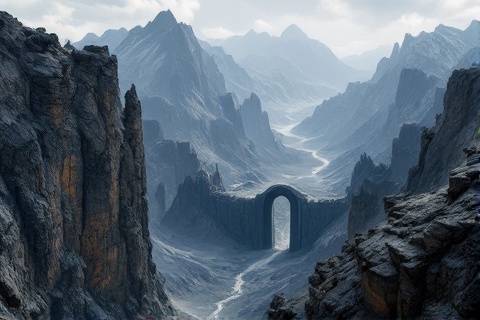
Mordor's formidable natural defenses consist of three imposing mountain ranges
that form an almost impenetrable wall around Sauron's
realm. The Ered Lithui, or Ash Mountains, stretch along the northern border,
their barren peaks perpetually shrouded in volcanic smoke from Mount Doom. The
Ephel Dúath, known as the Mountains of Shadow, form the western and southern
boundaries, their jagged peaks casting long shadows over the lands beyond. The
innermost range, the Morgai, creates an additional barrier of steep cliffs and
treacherous valleys, making any attempt to enter Mordor even more perilous.
The infamous Black Gate, known in Sindarin as the Morannon, stands as an
impregnable barrier at the northwestern entrance of Mordor, where the mountain
ranges of Ered Lithui and Ephel Dúath meet at the pass of Cirith Gorgor. Built
during the Second Age by the Gondorians to prevent evil from
escaping Mordor, this massive fortification later became Sauron's primary
entrance to his realm. The gate consists of two enormous doors of iron and
steel, flanked by towers carved from the mountain rock, and is designed to
withstand any assault while allowing Sauron's armies to march forth when needed.
The plateau of Gorgoroth dominates the central region of Mordor, forming a vast
and desolate plain that stretches for leagues in all directions. This barren
expanse serves as the heart of Sauron's realm, where nothing grows and the very
ground is covered in ash and sharp rocks. The plateau's strategic importance
lies in its position between Mount Doom and Barad-dûr, as well as its role as a
gathering point for Sauron's massive armies before they march to war. The harsh
conditions of Gorgoroth reflect the evil that permeates the land, making it
uninhabitable for all but the most hardy of Sauron's servants.
The southern region of Nurn presents a stark contrast to the desolation of
northern Mordor, surrounding the vast inland Sea of Núrnen with surprisingly
fertile lands. This area serves as Mordor's agricultural center, where slaves
cultivate crops to feed Sauron's armies. The Sea of Núrnen, fed by rivers
flowing from the surrounding mountains, provides the necessary water for farming
in this otherwise harsh realm. Unlike the wasteland of Gorgoroth, Nurn contains
actual soil and can support plant life, making it essential for sustaining
Mordor's massive military force.
The Volcanic Heart: Orodruin (Mount Doom)
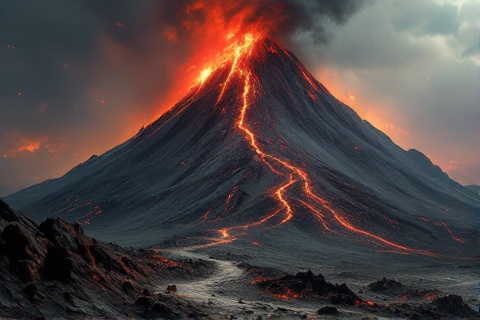
Mount Doom, known in Sindarin as Orodruin and in the Black Speech as Amon
Amarth, looms over the plain of Gorgoroth as a constant reminder of Sauron's
power. The mountain's perpetual activity manifests in continuous eruptions,
sending forth flames, ash, and toxic fumes that spread across Mordor. The
volcano's red glow illuminates the dark skies above Gorgoroth, creating an
ever-present twilight that adds to the land's forbidding atmosphere. The
mountain's chemical emissions help maintain the poisonous atmosphere that makes
the air itself a weapon against invaders.
The creation of Mount Doom dates back to the First Age, when
Melkor, the first Dark Lord, raised the volcano as part of
his efforts to corrupt and dominate Middle-earth. Sauron
later chose this mountain for its unique properties and powerful connection to
the evil that permeated Mordor. In the Second Age, he used its intense fires to
forge the One Ring, infusing it with his own power and
malice. The volcano's flames possess special properties that make it the only
place where the One Ring can be unmade, binding the mountain's fate inextricably
to that of Sauron and his greatest creation.
The landscape surrounding Mount Doom is a hellish terrain of volcanic debris and
ancient lava flows that have solidified into razor-sharp rocks. A treacherous
road winds its way up the mountain's slopes, constructed by Sauron's slaves to
allow access to the Sammath Naur, the Chambers of Fire, where the One Ring was
forged. The entire area around the volcano is covered in thick layers of ash
that never settle, making travel difficult and dangerous. Steam vents and
sulfurous gases emerge from countless fissures in the ground, creating an
environment hostile to all forms of life.
Dark Tower: Barad-dûr and Its Architecture
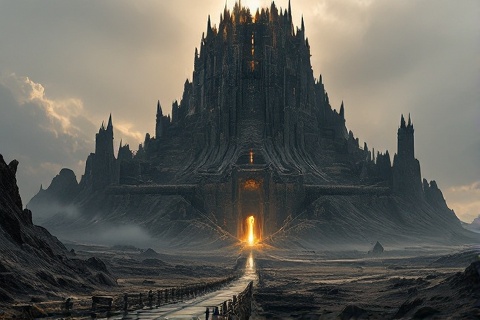
Barad-dûr, the Dark Tower, stands as the greatest and most formidable fortress
ever constructed in the history of Middle-earth. Its construction began around
Second Age 1000 and continued for six hundred years, demonstrating the immense
scale and complexity of its architecture. The tower served as Sauron's primary
stronghold and the center of his power, from which he directed his forces and
exercised his will over Middle-earth. Even the foundations of Barad-dûr took
centuries to complete, as Sauron insisted on creating an impregnable fortress
that would stand forever.
The construction of Barad-dûr utilized materials of unprecedented strength and
durability. Its walls were fashioned from black iron, steel, and adamant,
materials chosen not only for their physical properties but also for their
ability to channel and contain Sauron's dark powers. The Dark Lord strengthened
these materials further through his sorcery, binding his own power into the very
stones of the fortress. This magical reinforcement meant that Barad-dûr could
only be destroyed if the One Ring, which contained much of Sauron's power, was
unmade.
The architectural complexity of Barad-dûr was unmatched, with its structure
rising in multiple tiers that reached heights never achieved before or since in
Middle-earth. Each level contained vast armories that equipped Sauron's armies,
dungeons that held his prisoners, and chambers where his servants carried out
his commands. The tower's pinnacle housed Sauron's personal chambers and the
platform where his great Eye surveyed the lands around Mordor. The scale of the
fortress was so immense that it could house tens of thousands of
orcs, trolls, and other servants simultaneously.
The defensive capabilities of Barad-dûr extended far beyond its main structure.
The fortress was surrounded by multiple rings of fortifications, including outer
walls, watchtowers, and defensive trenches that made any approach impossible
without detection. A raised road connected the Dark Tower to Mount Doom,
allowing for swift movement of troops and supplies between these two crucial
locations. The entire complex was designed to be self-sufficient during sieges,
with vast storehouses, weapons repositories, and water supplies ensuring that it
could withstand any attempt at conquest.
The Plateau of Gorgoroth
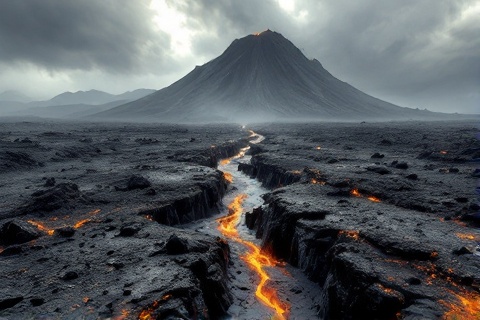
The Plain of Gorgoroth stands as one of the most inhospitable regions in all of
Middle-earth, its surface composed entirely of volcanic ash, dust, and jagged
rock fragments from Mount Doom's endless eruptions. This vast wasteland
stretches for many leagues between Barad-dûr and Mount Doom, creating a natural
proving ground for Sauron's armies. The harsh environment serves as both a
defensive advantage and a challenge, as only the most determined or evil
creatures can survive long exposure to its toxic atmosphere and treacherous
terrain.
The geological features of Gorgoroth bear witness to countless volcanic events
throughout its history. Deep fissures crack the earth's surface, some releasing
toxic fumes and others revealing the molten rock that flows beneath. Ancient
lava flows have created ridge lines and valleys of black stone, while newer
eruptions continuously reshape the landscape. These features make navigation
treacherous for those unfamiliar with the terrain, as many chasms are hidden by
ash drifts and toxic fog.
Despite its hostile environment, the Plain of Gorgoroth serves as the industrial
heart of Mordor. Countless military camps dot the landscape, housing the vast
armies that Sauron amasses for his war against the free peoples of Middle-earth.
Massive forges operate continuously, their fires fed by the heat from Mount Doom
itself, producing weapons and armor for Sauron's forces. Slave works scatter
across the plain, where captives labor in terrible conditions to support
Mordor's war machine, constructing siege engines and maintaining the network of
roads that connect Sauron's military installations.
A perpetual twilight shrouds the Plain of Gorgoroth, created by the thick fumes
that pour from Mount Doom's crater. These volcanic emissions mix with the smoke
from thousands of forges and fires, creating a poisonous atmosphere that blocks
most natural light. This eternal gloom serves Sauron's purposes well, as it
protects his light-hating servants from the sun while creating conditions that
demoralize and disorient any invaders who might penetrate Mordor's outer
defenses.
The Fertile South: Nurn and the Sea of Núrnen

The Sea of Núrnen stands as a crucial resource in Mordor's infrastructure,
providing the water necessary for maintaining the region's agricultural
production. This vast inland sea receives water from multiple rivers flowing
down from the surrounding mountains, creating a sustainable water source that
enables farming in the otherwise harsh environment. The sea's waters, while
tainted by the evil of Mordor, remain sufficient for irrigation and sustaining
the slave-worked farms that line its shores.
The agricultural regions surrounding the Sea of Núrnen represent Mordor's
primary food production center, where thousands of slaves work the fields under
the harsh oversight of Sauron's overseers. These farmlands produce the grain and
other sustenance required to feed the massive armies that Sauron maintains in
Gorgoroth and other regions of his realm. The agricultural system employs brutal
efficiency, with every aspect of production focused on maximizing output to
support Mordor's military machine.
The southern region of Nurn offers a marked contrast to the desolation of
northern Mordor, featuring actual soil capable of supporting vegetation and
crops. While still harsh by the standards of other lands in Middle-earth, this
area contains enough fertile ground to maintain substantial agricultural
production. The presence of natural vegetation, though sparse and hardy,
demonstrates the region's capacity to support life, making it vital to Mordor's
ability to sustain its vast military forces.
A complex network of roads and settlements supports the agricultural system of
Nurn, connecting the farming regions to the military installations in the north.
Storage facilities, distribution centers, and garrison posts ensure the
efficient movement of supplies throughout Mordor. The settlements themselves
consist primarily of slave quarters and military outposts, with Sauron's
commanders maintaining strict control over both the worker population and the
movement of agricultural products.
Gates and Passages: The Ways Into Mordor
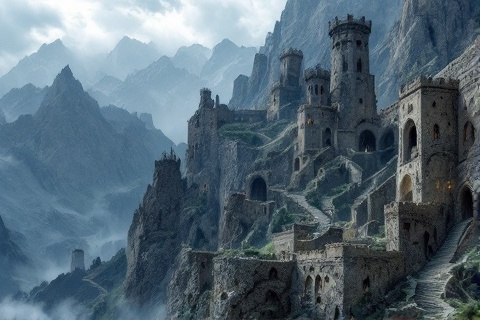
The Black Gate stands as Mordor's primary entrance and most formidable defensive
structure, controlling access through the northwestern passage of Cirith Gorgor.
Built originally by the men of Gondor to contain evil within
Mordor, the Morannon later became Sauron's greatest fortification, allowing him
to regulate all traffic through this crucial chokepoint. The massive iron gates,
supported by two immense towers known as the Towers of the Teeth, create an
almost impenetrable barrier that can withstand significant military assault.
The pass of Minas Morgul, formerly known as Minas
Ithil when it belonged to Gondor, provides another major
access point through Mordor's western mountains. This passage, controlled by the
terrible city of Minas Morgul, serves as a strategic route for Sauron's forces
to move between Mordor and the lands of Gondor. The very presence of the Morgul
Vale instills fear in potential invaders, as the area is permeated with dark
magic and guarded by the Nazgûl.
Throughout the mountain ranges surrounding Mordor, numerous secret passages
offer hidden ways into the Dark Land. The most notorious of these is the pass of
Cirith Ungol, guarded by the tower of the same name and
its garrison of orcs. These concealed routes, while potentially useful for small
groups seeking to enter or leave Mordor undetected, are often protected by more
than just military forces. The pass of Cirith Ungol, for instance, is home to
Shelob, a monstrous spider-creature who serves as an
additional deterrent to would-be infiltrators.
The combination of natural barriers and strategic fortifications makes Mordor
one of the most defensible regions in Middle-earth. The mountain ranges
themselves present a formidable obstacle, with their steep cliffs and
treacherous paths deterring casual approach. Strategic placement of fortresses
and watchtowers ensures that no significant force can approach without
detection. The few passes through the mountains are heavily fortified, while the
terrain itself serves as a weapon against invaders, with toxic fumes, lack of
water, and harsh conditions wearing down any army that might breach the outer
defenses.
